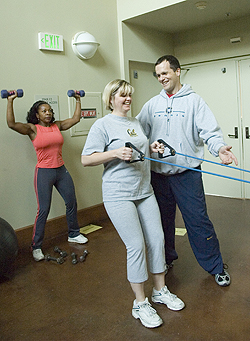Berkeleyan
Get up off your good intentions
Campus exercise programs help employees stand up for fitness
![]()
| 08 December 2005
Leo Ricks knows the exact number of steps between the downtown Berkeley BART station and his desk at the College of Natural Resources greenhouse at Walnut Street and Oxford Avenue. Not only is the nursery technician well acquainted with those particular 479 steps, but since September he's been using a pedometer and a spreadsheet to track his daily walks. He notes with some pride that on several days he's racked up 15,000 steps, the equivalent of 7.5 miles.
Ricks, who quit a longstanding cigarette habit two months ago, is in good company as he pursues a healthier lifestyle. His supervisor, Barbara Rotz, gave him and seven other nursery staffers release time to attend nutrition- and pedometer-focused courses through Health*Matters, the campus wellness program. Rotz even purchased pedometers for her staff, saying that the step counter is "great just for awareness."
Rotz's group egged one another on when they first started wearing their pedometers, checking on how many steps each person had taken. "They feel better about themselves," their supervisor notes. "I've always believed that your life isn't just your job. If you get healthier, you get happier."
Al Hunter, a senior nursery technician at the greenhouse, also made significant lifestyle changes. Hunter, who says he used to eat a lot of fast food, noticed that his diet has changed considerably since taking Health*Matters' nutrition course: "I'm cooking more, and eating less red meat and more vegetables. I've also had to make more notches in my belt." He adds that he's lost about 15 pounds since embarking on a regular walking routine.
No excuses!
 Pumped up: Anita Stephens (left), Jennifer Sullivan, Haas wellness coordinator/participant, and Devin Wicks, RSF instructor. (Deborah Stalford photo) |
Twenty-three people took part in the WorkFit pilot program at Haas, including Lee Forgue, an administrative specialist in the MBA admissions office. "My energy is up and my range of motion is better," reports Forgue, who taught medieval dance until 10 years ago, when it became too draining. Just recently she spent an entire Saturday dancing. "I'm pretty impressed with myself," she chuckles.
"The wonderful thing about having the class right here is that there are no excuses. We all look at each other and say, 'You're going, right?' The program has made a huge difference to me," she says. "I feel better about myself."
After the initial six-week session, a survey was conducted to assess how WorkFit had been received. "I knew that people were happy with the program, but I didn't expect everybody to take the survey and everybody to be glowing about it," says Alice Kubler, an assistant dean who has been involved with the program from the outset. "What I don't think people expected is that it would be fun and that they would be energized by the class."
Taking the highest road
The Office of Environmental Health and Safety (EH&S) chose an unusual route to get people in the department enthusiastic about health: Those staffers who wished to could participate in a climb to the top of Mt. Everest. While the group didn't literally ascend the world's highest peak, they took a path to fitness that was closer to home.
Tim Bean, chair of the office's events team, calculated the distance from University Hall's ground floor to EH&S's third-floor offices - 31 feet. Then he figured out that 980 trips up the three flights of stairs would approximate the distance to Everest's 29,035-foot summit.
To get prospective participants enthused, Bean invited Health*Matters' health educator Kristl Buluran to an all-staff event to give the Step It Up! workshop on pedometers. EH&S Director Mark Freiberg purchased the step-counters for his entire staff of 65. "It seemed like a relatively small thing that I thought would help ensure maximum participation in the fitness program," he explains.
Thirty-three EH&S staffers chose to strap on their figurative crampons and climb the stairs each day. Bean posted a spreadsheet by the top of the stairs on their floor, where climbers noted their every ascent with a hash mark. To inspire them, Bean created a poster featuring famous summits and tall buildings, beginning with the Eiffel Tower (1,052 feet) and a number of mountains - Diablo, Whitney, Denali, Fuji, and Kilimanjaro, listing facts and trivia about each - and then purposefully tacked it on a wall opposite the elevator.
The pedometers "caused a lot of buzz," says Bean. Not everyone wanted to hike up the stairs, so he calculated how many calories climbing three flights of stairs would consume (about 25), then ascertained how much walking would burn that same number (about 100 steps). It took three-and-a-half weeks for the group to summit Mt. Everest. After reaching their goal they celebrated with sparkling apple cider, toasting one another for their contributions.
Bean and the EH&S events team are already planning future fitness challenges for their co-workers. Next up: a walk from Berkeley to Manhattan.

